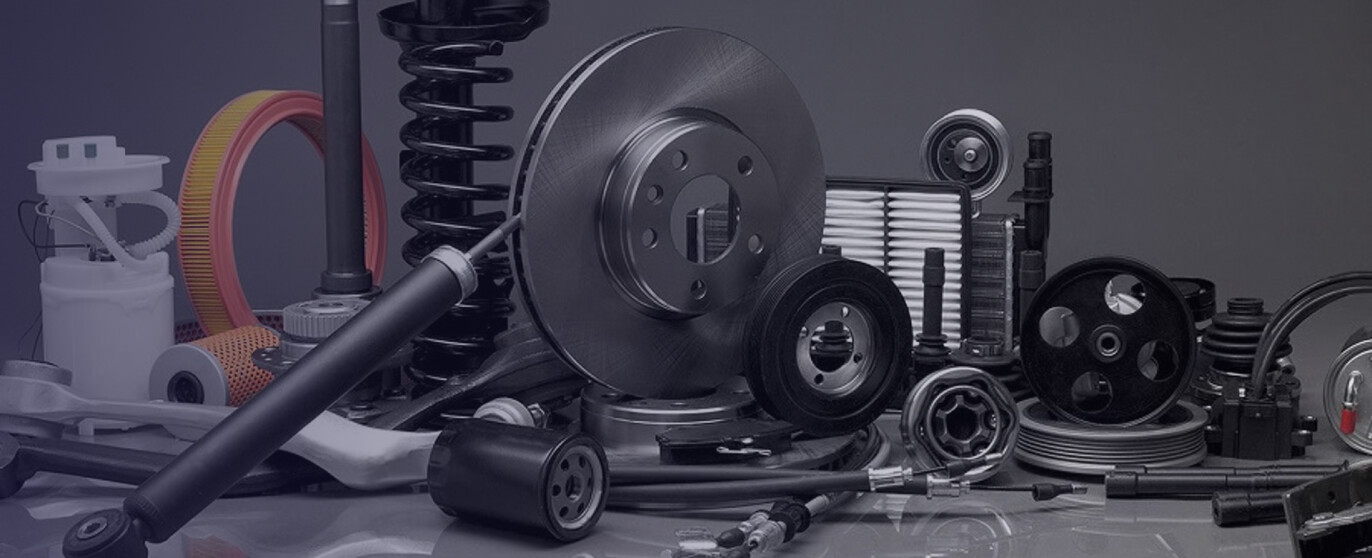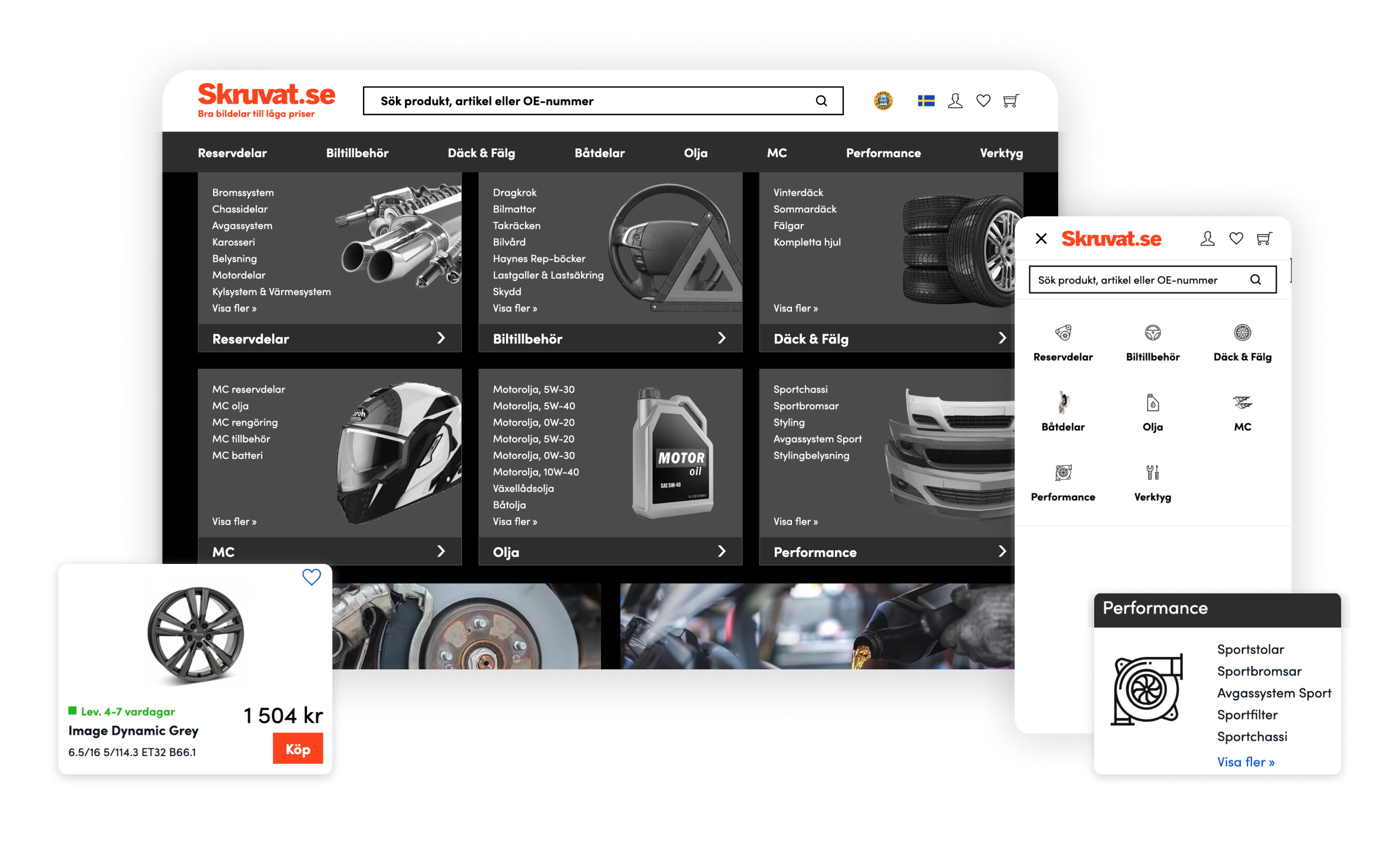

Skruvat has grown astonishingly in the last couple of years, establishing itself as a retail leader in the car spare parts market. However, the company began to encounter roadblocks as the eCommerce platform, which had been in use for over 15 years, became more of an obstacle than an enabler of growth.
One of the main areas of capturing market share is expanding the product range of spare parts and accessories. Adding more SKUs to the previous platform became increasingly difficult and time-consuming for the company. The legacy platform, built on AbleCommerce, was rigid to the point where changing one area often triggered issues in another. Skruvat had accumulated so much technical debt that developers spent more time fixing bugs and maintaining the system than building new features.
Magnus Johansson, Product Owner at Skruvat, said, “Everything that we put in this big monster monolith made it harder to keep up a higher pace when developing new features. When we changed something at one end, another stopped working. We had many challenges in delivering the pace that the business needed.”
The marketing side of the business struggled, too. Creating marketing campaigns was a slow process: Launching a single campaign, including setting up banners and ensuring everything appeared correctly on the site, could take hours. This often required multi-departmental coordination to ensure all elements were ready for launch, with much of the execution relying on the tech team. This workflow made the process inefficient and prone to errors, and limited the marketing team’s ability to act quickly and independently, ultimately affecting the business negatively.
Performance had also become a serious concern for the engineering team, led by Stefan Byström. Pages could take tens of seconds to load during high-traffic periods, creating poor user experiences and missed revenue opportunities.
Skruvat recognized the need for a more resilient and flexible solution that could keep pace with the rapidly evolving demands of modern eCommerce. Cross-functional teams, including engineering, product and operations, worked closely together to define both business and technical requirements, ensuring alignment across the organization.
The company sought a platform that could enhance performance and SEO, reduce its reliance on developers for day-to-day operations, and expedite onboarding for new engineers. Most importantly, they needed a strong technical foundation to support ongoing product expansion, entry into new markets and the launch of future business initiatives.
To overcome so many technical limitations and enable business growth through technology, Skruvat set out to modernize its digital commerce infrastructure to meet ambitious goals:
Handle and grow their product catalog, support rapid deployment of new features and integrate smoothly with other tools through open APIs.
Reduce dependency on developers for daily tasks, empowering marketers to efficiently manage the customer experience layer and campaigns.
Improve performance and scalability across markets, focusing on stability, speed and SEO readiness.
To achieve these goals, the technical team chose a composable commerce platform powered by commercetools and a CMS by Contentful. The modularity of these solutions enabled Skruvat to take a phased migration approach, instead of overhauling everything at once. As a starting point, the company left the existing frontend untouched while modernizing the backend under the guidance of system integrator Avensia, allowing for a smoother transition and minimal business disruption.
Rather than building from the ground up, Skruvat leveraged Avensia Excite, a pre-packaged composable commerce accelerator that had already proven successful with six other Nordic retailers. This battle-tested foundation meant Skruvat could start with a fully functional commerce site and focus on customization rather than fundamental development.
This initial rollout was completed in four months, which was achievable because Excite eliminated the need to solve fundamental commerce challenges from scratch. Instead of spending months on architecture decisions, integration planning and performance optimization, Skruvat’s team could immediately focus on their specific automotive industry requirements and user experience customizations.
For the marketing team, the benefit was instant. Tasks that previously required developer involvement, such as launching campaigns or editing site content in HTML code, can now be directly handled by marketers. “Now it’s a much smoother way to work for the marketing team,” said Cecilia Horvath, Skruvat CMO. “Just setting up campaigns in such an easy way, and then choosing to put them up for different countries, was a game-changer for us. Sure, it was a learning curve. But now, it’s very easy for non-technical professionals to use.”
Skruvat’s benefits extend to flexibility and experimentation. Developers find the new system easier to work with, whether they’re integrating new payment providers or generating custom APIs for accessing sales data.
commercetools was the right choice for us. Its flexible, enterprise-grade platform, powered by strong API coverage, allows us to do far more than we could before. The composable approach helped us build a future-proof foundation, and now we can finally deliver what the business needs in smarter ways. For instance, we’ve started shifting from choosing the shipping carrier ourselves to letting customers select their preferred delivery option. This was something that simply wasn’t possible with our previous eCommerce platform.
CTO, Skruvat
The transition to a composable architecture marked a major turning point for Skruvat. Even in the early implementation phases, the new setup brought tangible efficiency, flexibility and business performance improvements. With commercetools and Contentful at the digital core, Skruvat’s marketing and technical teams can move faster and operate more independently. Tasks that previously required developers are now handled by the marketing team, cutting campaign setup time in half and enabling faster time-to-market.
This shift has led to a dramatic increase in productivity. Developers now spend around 90% of their time on value-adding initiatives, rather than maintenance or support, up from 40% when they worked on the legacy platform. The platform’s API-first approach allows the team to quickly create and expose custom data integrations, whether for internal needs or third-party tools, bringing new ideas to life much faster.
As Magnus Johansson put it, “From my perspective, it’s incredibly easy to integrate with. Whether our in-house team builds something quickly or creates APIs for external systems, we can access data in just a few clicks. The time it takes from a business requirement to release is impressively short."
The customer experience has also improved significantly. Skruvat saw its Google PageSpeed score jump from 15 to 80 with a faster, more stable site. The smoother site performance has contributed to a better user journey, and introducing more tailored content and more straightforward navigation is starting to show a positive business impact. While conversion rates are still being optimized, the average basket value has already increased by 5%, a clear signal that customers are engaging with more of what Skruvat offers.
With reduced operational overhead, the business can now focus on strategic goals, like expanding the product catalog and experimenting with bundling and personalization. For instance, the team is exploring advanced capabilities, such as AI, to further enhance marketing efficiency and customer targeting.
Entering new markets has also become a simpler process, to the extent that Skruvat expanded to Denmark in just four weeks, while simultaneously launching a mobile app.
Most significantly, the project has sparked a cultural shift. Skruvat’s teams now approach innovation with more confidence and clarity, empowered by a platform that adapts to their needs — not the other way around.
“We’re still discovering new possibilities, but the mindset shift has already happened,” shared Cecilia Horvath, CMO. “Now I can easily connect media spend with sales data, not just GA (Google Analytics) metrics. We use tools to build direct connectors with commercetools, so we’re getting real, actionable insights. Now I don’t have to waste time on old systems and routines. It’s a big step forward, and honestly, I’m excited about what the future will bring.”
Skruvat can add new SKUs to its extensive product assortment at scale, allowing it to provide customers with the products they want.
Managing time-critical promotions, discounts and campaigns is easy for marketers using a no-code tool.
commercetools’ business tooling empowers marketers to manage eCommerce from an easy-to-use interface, without depending on developers.
